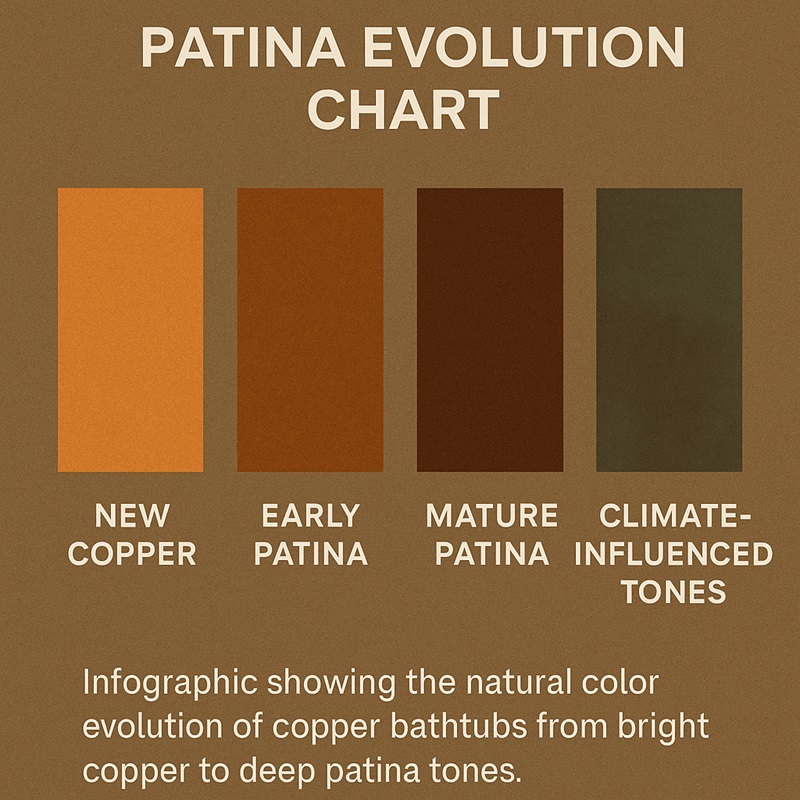Quick Answer: Are Copper Bathtubs Worth It?
A copper bathtub is worth the investment if you want a tub that is beautiful, long-lasting, eco-friendly, and naturally clean. Copper holds heat longer, kills bacteria, resists rust, and can last 40–100+ years. While expensive upfront, it delivers luxury, performance, and sustainability that cheaper tubs cannot match.
Why Copper Still Leads in Luxury Design
Copper has a look that never goes out of style. Its warm, rich tone brings instant character to a bathroom, and the metal changes color slowly over time, creating a natural patina that feels alive and artistic. A copper bathtub doesn’t just sit in a room—it transforms it.
Because the metal is soft and easy to shape, artisans can craft dramatic silhouettes, deep curves, and striking textures. Whether you prefer a modern, smooth look or a vintage clawfoot style, copper offers almost unlimited design freedom.
CopperSmith, one of the leaders in handcrafted copper tubs, is known for this level of detail. With thousands of five-star reviews and custom finishes, they allow homeowners to select size, texture, and patina that fit their exact vision.

The Science Behind Patina — Why Your Tub Changes Color Over Time
Patina is copper’s natural “aging finish.”
As the metal meets air, water, and minerals, it slowly shifts into richer tones — amber, cocoa, chestnut, or even hints of green in some climates.
Why this happens:
- Oxygen reacts with the surface
- Minerals in your water leave micro-marks
- Humidity deepens color patterns
- Light exposure creates subtle highlights
This process protects the copper and gives your tub a story — a look shaped by your home’s air, water, and daily routines.
Inside the Workshop — How Copper Bathtubs Are Handcrafted
Unlike factory-pressed acrylic tubs, real copper tubs are made by hand.
The artisan process includes:
- Cutting thick copper sheets
- Hammering them into shape
- Heating and cooling to harden the metal
- Forming the interior curve
- Texturing, brushing, or polishing
- Adding the final patina finish
Each step takes hours of skilled labor.
This craftsmanship is why copper tubs last so long — and why they feel like functional art.
Sensory Luxury — The Experience You Can Feel, Not Just See
Soaking in a copper bathtub feels warm from the moment you step in. The metal heats fast, so your hands and feet touch a surface that feels soft and welcoming, not cold.
As the tub fills, the heat spreads through the copper walls. The whole tub stays warm, making your bath feel calm and cozy.
Candlelight reflects off the curved copper surface, adding a soft glow to the room. The smooth shape of the tub supports your body and helps you relax.
A copper bath turns a simple routine into a small daily ritual — warm, soothing, and spa-like.
Water Chemistry — How Your Local Water Changes the Tub
A copper tub reacts to water the same way skin reacts to weather.
Hard water can deepen the patina and create darker tones.
Soft water keeps the surface smoother and more even.
Homes with well water often see the patina form faster.
Chlorinated city water slows the color change and keeps the copper bright for longer.
Each of these small shifts makes the tub look unique.
Your local water shapes the color and feel of the copper, giving your bathtub a look that belongs only to your home.
Why Top Spas and Boutique Hotels Choose Copper Tubs
Luxury hotels and spas love copper tubs because they offer:
- High durability under heavy use
- Warm, relaxing baths for guests
- A photogenic focal point for branding
- Easy natural sanitation
- A long life cycle with almost no replacement needs
If a material is trusted by spas, it’s ideal for home wellness.
Design Pairings — Materials That Match Copper Perfectly
For a standout bathroom, pair your copper tub with:
- White or black marble
- Slate or charcoal tile
- Warm wood accents
- Matte black or brushed brass fixtures
- Natural linen or stone accessories
Copper adapts to modern, rustic, tropical, and luxury spa themes with ease.
Copper Through History — From Ancient Rituals to Modern Wellness
Copper bathtubs aren’t new. They have been celebrated for thousands of years.
- Ancient Egypt: ritual cleansing
- Roman baths: heated metal tubs
- Ayurveda: copper water for wellness
- Victorian homes: hand-hammered soaking tubs
- Modern design: eco-luxury spa bathrooms
Copper has always symbolized purity, warmth, and longevity.
The Thermal Secret — Why Copper Makes the Warmest Baths
Copper holds heat better than acrylic, stone resin, or fiberglass.
How it works:
- Copper absorbs heat quickly
- It releases heat slowly
- The entire tub warms evenly
This means:
- fewer refills
- longer, steadier soaks
- a more relaxing experience
It’s one of the biggest benefits of copper tubs.
Durability: A “Forever” Material That Holds Its Value
Copper is one of the most durable materials used in home building. A high-quality copper tub can last 40–100+ years, far longer than acrylic or fiberglass.
Why Copper Lasts Longer
- It doesn’t crack or chip.
- It’s naturally resistant to rust and corrosion.
- Thick copper (14–16 gauge) handles dents and stress better than thin copper.
High-end makers like CopperSmith use thicker gauges, which gives the tub structure, strength, and long-term performance.
Performance and Comfort: Warmer Water, Longer Baths
Copper keeps water warm longer than many other materials because it conducts and holds heat extremely well. Your bath stays cozy without refilling hot water again and again.
What It Means for You
- Longer relaxation
- More stable heat
- A spa-like experience at home
Copper is also naturally antimicrobial. Research shows it can reduce bacteria on its surface without chemicals, making it a cleaner option for homes with kids, pets, or sensitive skin.
Sustainability: A Smarter Choice for the Planet
Copper is one of the most recyclable materials in the world. It can be reused over and over without losing quality.
Eco Facts
- Most copper products contain 60–80% recycled content
- Copper can last over a century
- A long lifespan means fewer replacements and less waste
CopperSmith and similar brands prioritize sustainable material sourcing and low-waste manufacturing.
Pricing
Copper tubs are a luxury product. Prices vary by size, gauge, and craftsmanship.
General Price Ranges
- Entry-level: $3,500–$6,000
- Mid-range handcrafted: $7,000–$12,000
- High-end custom: $12,000–$20,000+
Factors that affect price:
- Copper thickness
- Hammered vs smooth finish
- Double-walled insulation
- Custom dimensions
- Unique patinas or textures
Copper costs more upfront, but the lifetime value is significantly higher than cheaper tubs.
Installation
Copper tubs are lighter than cast iron but heavier than acrylic.
Weight Overview
- Acrylic: 70–120 lbs
- Copper: 120–200 lbs
- Cast iron: 300–500 lbs
Do You Need Floor Reinforcement?
Most bathrooms do not need structural reinforcement for a copper tub, but you should:
- Check if the floor supports 350–450 lbs when filled with water
- Confirm plumbing alignment for freestanding installations
- Use a professional installer for stability and leveling
Care & Maintenance
Copper tubs are easier to care for than most people expect.
Basic Routine
- Rinse after each use
- Wipe dry to minimize water spots
- Use mild soap (no harsh chemicals)
- Allow patina to form naturally
If You Prefer a Bright, Shiny Look
Apply a copper wax every few months to slow patina development.
Copper vs Other Tub Materials
| Feature | Copper | Acrylic | Cast Iron | Stone Resin |
| Heat retention | Excellent | Poor | Excellent | Medium |
| Weight | Medium | Light | Very heavy | Heavy |
| Lifespan | 40–100+ yrs | 10–15 yrs | 50+ yrs | 25–40 yrs |
| Sustainability | Very high | Low | Medium | Medium |
| Antimicrobial | Yes | No | No | No |
| Cost | High | Low | Medium | High |
Copper wins in: longevity, heat retention, sustainability, and hygiene.
Understanding Copper Gauge
The gauge tells you how thick and strong the copper is.
- 14–16 gauge: Best quality. Thick and strong.
- 18 gauge: Standard and still solid.
- 20–22 gauge: Can dent. Best to avoid.
Always ask the seller what gauge they use before you buy a tub.
Pros & Cons of Copper Bathtubs
⭐ Pros
- Holds heat very well
- Lasts for many years
- Naturally antimicrobial
- Fully recyclable
- Beautiful design
- Easy to customize
- Low-maintenance
⚠️ Cons
- Costs more at the start
- Patina look may not fit every style
- Can scratch (but scratches blend in over time)
- Needs gentle cleaners
Buyer’s Checklist
Before you buy, check:
- Copper gauge (14–16 is best)
- Type of finish (bright, medium, patina)
- Inside width and soaking depth
- Single vs. double-walled build
- Overflow options
- Warranty
- Return rules for custom orders
These steps help you get a tub that fits your space and long-term plans.
Why Copper Bathtubs Add Real Home Value
Buyers who want high-end homes look for:
- Natural materials
- Eco-friendly features
- Spa-like bathroom design
A copper bathtub checks all these boxes.
It stands out in real estate photos and often raises the way buyers see your home’s value.
Conclusion: A Luxury Upgrade That Lasts
A copper bathtub is more than a pretty feature.
It is a long-lasting, smart upgrade. It blends beauty, comfort, and sustainability.
Copper keeps heat well, fights germs on its own, and can last for many decades.
If you want a bathroom that feels warm, timeless, and eco-friendly, a handcrafted copper tub is a great choice.
It looks stunning today — and will still impress many years from now.






